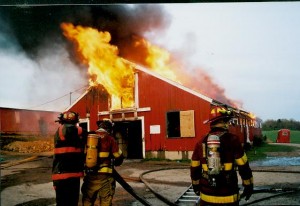
By Pat Raia
From thehorse.com website.
Horse owners got a grim reminder about fire dangers when a blaze swept through a barn containing world class competition horses last month. Barn owners and operators are frequently informed about how to reduce fire risks, but knowing how to react if a fire does break out is equally crucial, explained Rebecca Gimenez, PhD, primary instructor and president of the Technical Large Animal Emergency Rescue.
Barn Fire
Knowing how to react in the face of a barn fire is key for survival.
On May 31 fire swept through a barn at True Prospect Farm in West Grove, Pa., where horses ridden by eventer and World Equestrian Games competitor Boyd Martin were stabled. The cause of the blaze has been deemed electrical. Six horses died in the blaze and five others were transported to the University of Pennsylvania’s New Bolton Center for treatment. As of June 7, all but one of the surviving horses had been released after treatment.
Gimenez said that in most cases barn operators or other personnel generally cannot reach animals quickly enough to avoid being overcome themselves by smoke or flames.
Gimenez said research has shown that most barns are fully involved in fire within five to seven minutes after a fire breaks out. The time frame is similar to the amount of time it takes for most rural and volunteer fire departments to arrive at a barn blaze site.
“Firefighters tell us that by the time they arrive, the barn is perfectly silent,” Gimenez said. “That means the horses have inhaled enough smoke to die and that the firefighters are putting water on the (barn) mostly to prevent other structures from catching on fire.”
Other data also shows that if one animal dies in a fire, the facility is usually a total loss, Gimenez said, “which means that it gets hot fast. Never should you encourage anyone to go into a burning barn.”
With just minutes to react, it is impossible to catch, halter, and lead a horse out of a burning barn in enough time to save it, Gimenez said.
“We have timed people making the effort to catch, halter, blindfold, and lead a horse in these conditions. It is essentially impossible,” she said.
Instead, chasing horses though an established fire lane is the best way to remove animals from a burning barn, Gimenez said.
Gimenez advises barn owners and operators to amend barn structures to include a fire lane which establishes an escape route for removing the animals during fire emergencies. Ideally, fire lanes should link from the outside doors of the horses’ stalls to paddock spaces or pastures well away from the barn.
“Chase the horses through the fire lane to a closable paddock or pasture away from the barn,” Gimenez said.
Understanding Equine Medications is your A-Z guide to learning more about generic and brand-name pharmaceuticals, possible side effects and precautions, and proper dosage.
Meanwhile, the presence of an appropriately installed sprinkler system can buy precious time when a barn fire breaks out, Gimenez said.
“Sprinkler systems can suppress a fire until firefighters arrive, attack the blaze, and possibly save animals’ lives,” Gimenez said. “The cost is not significant compared to the price of your animals, the facility, and your conscience. Additionally, you can usually get a lowered premium on your insurance.”
